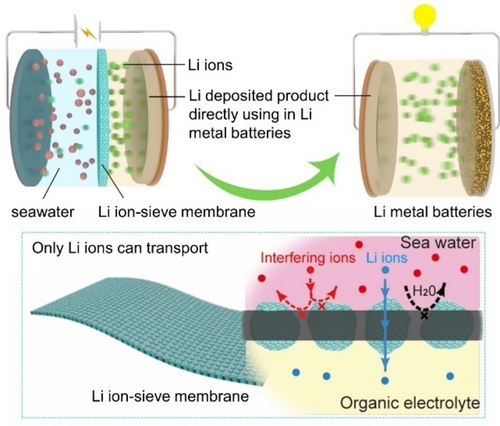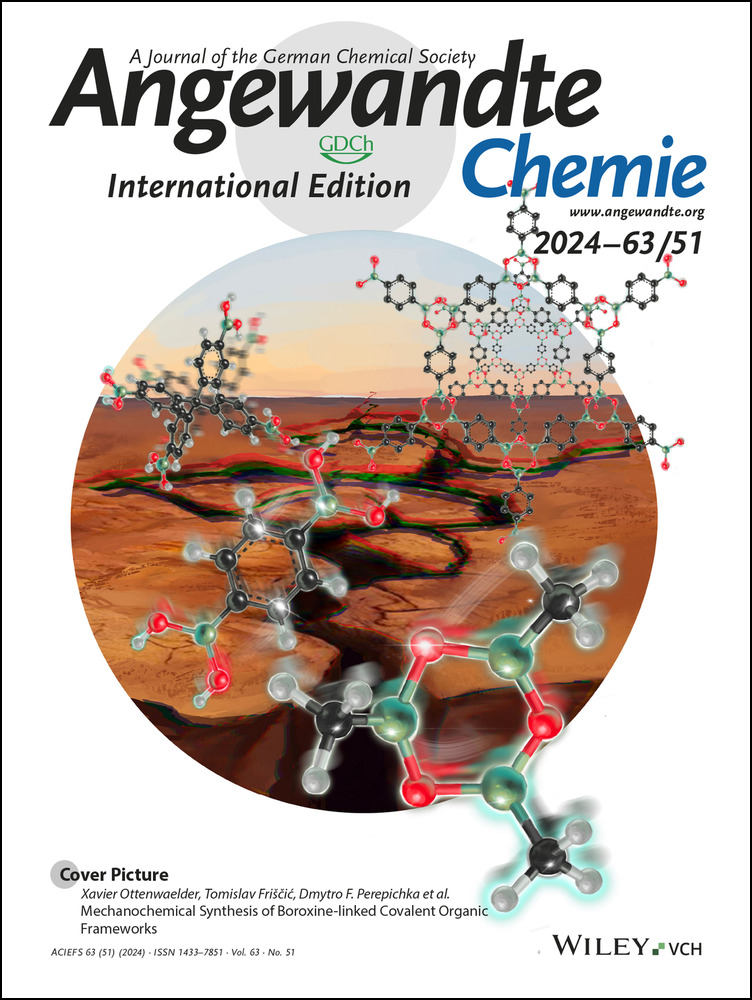Lithium Metal Recovery from Sea Water by a Flexible and Scalable Membrane with Lithium-Ion Exclusive Channels
Jingui Yang
Center of Energy Storage Materials & Technology, College of Engineering and Applied Sciences, Jiangsu Key Laboratory of Artificial Functional Materials, National Laboratory of Solid State Microstructures, Collaborative Innovation Center of Advanced Microstructures, Nanjing University, 210093 Nanjing, PR China
These authors contributed equally.
Search for more papers by this authorYigang Wang
Center of Energy Storage Materials & Technology, College of Engineering and Applied Sciences, Jiangsu Key Laboratory of Artificial Functional Materials, National Laboratory of Solid State Microstructures, Collaborative Innovation Center of Advanced Microstructures, Nanjing University, 210093 Nanjing, PR China
These authors contributed equally.
Search for more papers by this authorMenghang Zhang
Center of Energy Storage Materials & Technology, College of Engineering and Applied Sciences, Jiangsu Key Laboratory of Artificial Functional Materials, National Laboratory of Solid State Microstructures, Collaborative Innovation Center of Advanced Microstructures, Nanjing University, 210093 Nanjing, PR China
Search for more papers by this authorPengfei Wang
Center of Energy Storage Materials & Technology, College of Engineering and Applied Sciences, Jiangsu Key Laboratory of Artificial Functional Materials, National Laboratory of Solid State Microstructures, Collaborative Innovation Center of Advanced Microstructures, Nanjing University, 210093 Nanjing, PR China
Search for more papers by this authorXuewei He
Center of Energy Storage Materials & Technology, College of Engineering and Applied Sciences, Jiangsu Key Laboratory of Artificial Functional Materials, National Laboratory of Solid State Microstructures, Collaborative Innovation Center of Advanced Microstructures, Nanjing University, 210093 Nanjing, PR China
Search for more papers by this authorCorresponding Author
Haoshen Zhou
Center of Energy Storage Materials & Technology, College of Engineering and Applied Sciences, Jiangsu Key Laboratory of Artificial Functional Materials, National Laboratory of Solid State Microstructures, Collaborative Innovation Center of Advanced Microstructures, Nanjing University, 210093 Nanjing, PR China
Search for more papers by this authorCorresponding Author
Ping He
Center of Energy Storage Materials & Technology, College of Engineering and Applied Sciences, Jiangsu Key Laboratory of Artificial Functional Materials, National Laboratory of Solid State Microstructures, Collaborative Innovation Center of Advanced Microstructures, Nanjing University, 210093 Nanjing, PR China
Search for more papers by this authorJingui Yang
Center of Energy Storage Materials & Technology, College of Engineering and Applied Sciences, Jiangsu Key Laboratory of Artificial Functional Materials, National Laboratory of Solid State Microstructures, Collaborative Innovation Center of Advanced Microstructures, Nanjing University, 210093 Nanjing, PR China
These authors contributed equally.
Search for more papers by this authorYigang Wang
Center of Energy Storage Materials & Technology, College of Engineering and Applied Sciences, Jiangsu Key Laboratory of Artificial Functional Materials, National Laboratory of Solid State Microstructures, Collaborative Innovation Center of Advanced Microstructures, Nanjing University, 210093 Nanjing, PR China
These authors contributed equally.
Search for more papers by this authorMenghang Zhang
Center of Energy Storage Materials & Technology, College of Engineering and Applied Sciences, Jiangsu Key Laboratory of Artificial Functional Materials, National Laboratory of Solid State Microstructures, Collaborative Innovation Center of Advanced Microstructures, Nanjing University, 210093 Nanjing, PR China
Search for more papers by this authorPengfei Wang
Center of Energy Storage Materials & Technology, College of Engineering and Applied Sciences, Jiangsu Key Laboratory of Artificial Functional Materials, National Laboratory of Solid State Microstructures, Collaborative Innovation Center of Advanced Microstructures, Nanjing University, 210093 Nanjing, PR China
Search for more papers by this authorXuewei He
Center of Energy Storage Materials & Technology, College of Engineering and Applied Sciences, Jiangsu Key Laboratory of Artificial Functional Materials, National Laboratory of Solid State Microstructures, Collaborative Innovation Center of Advanced Microstructures, Nanjing University, 210093 Nanjing, PR China
Search for more papers by this authorCorresponding Author
Haoshen Zhou
Center of Energy Storage Materials & Technology, College of Engineering and Applied Sciences, Jiangsu Key Laboratory of Artificial Functional Materials, National Laboratory of Solid State Microstructures, Collaborative Innovation Center of Advanced Microstructures, Nanjing University, 210093 Nanjing, PR China
Search for more papers by this authorCorresponding Author
Ping He
Center of Energy Storage Materials & Technology, College of Engineering and Applied Sciences, Jiangsu Key Laboratory of Artificial Functional Materials, National Laboratory of Solid State Microstructures, Collaborative Innovation Center of Advanced Microstructures, Nanjing University, 210093 Nanjing, PR China
Search for more papers by this authorGraphical Abstract
Abstract
Sea water is abundant in lithium reserves, and extracting lithium metal from it holds the potential to not only mitigate the shortage of lithium in light of the fast-growing electric vehicle industry, but also serve as an anode electrode to provide electricity. The task, however, is challenging due to the harsh reactions and low lithium concentration in sea water. Here, we present a single-channel strategy based on a flexible and scalable lithium ion-sieve membrane for efficient lithium extraction. Our composite membrane exhibits high separation factor βLi/Na of more than 2.87×107 with an ionic conductivity of 6.2×10−5 S cm−1. Lithium metal was electrolytically extracted from sea water through a hybrid-electrolyte system, which yielded a high Coulombic efficiency of 98.04 % and a low energy consumption of 17.4 kWh kgLi−1 at an optimized extracting current of 200 μA cm−2. The extracted lithium metal can be directly integrated into a lithium-sulfur battery, delivering an energy output of 395 Wh kg−1. To demonstrate its industrial viability, we also fabricate a pouch cell with Li metal anode extracted by an amplified extraction prototype. This study has the potential to dispel concerns of lithium depletion and facilitate the sustainable development of lithium-based energy storage systems.
Conflict of Interests
The authors declare no conflict of interest.
Open Research
Data Availability Statement
The data that support the findings of this study are available from the corresponding author upon reasonable request.
Supporting Information
As a service to our authors and readers, this journal provides supporting information supplied by the authors. Such materials are peer reviewed and may be re-organized for online delivery, but are not copy-edited or typeset. Technical support issues arising from supporting information (other than missing files) should be addressed to the authors.
| Filename | Description |
|---|---|
| anie202411957-sup-0001-misc_information.pdf1.3 MB | Supporting Information |
| anie202411957-sup-0001-Revised_video_S1.mp435.2 MB | Supporting Information |
Please note: The publisher is not responsible for the content or functionality of any supporting information supplied by the authors. Any queries (other than missing content) should be directed to the corresponding author for the article.
References
- 1P. G. Bruce, S. A. Freunberger, L. J. Hardwick, J. M. Tarascon, Nat. Mater. 2012, 11, 19–29.
- 2Y. Zhang, T. T. Zuo, J. Popovic, K. Lim, Y. X. Yin, J. Maier, Y. G. Guo, Mater. Today 2020, 33, 56–74.
- 3United States Geological Survey. Mineral Commodity Summaries 2024, United States Geological Survey, Reston, VA, 2024.
- 4
- 4aIEA, Global EV Outlook 2021, IEA, Paris, France, 2021;
- 4bP. Greim, A. A. Solomon, C. Breyer, Nat. Commun. 2020, 11, 4570.
- 5C. Xu, Q. Dai, L. Gaines, M. Hu, A. Tukker, B. Steubing, Commun. Mater. 2020, 1, 99.
- 6M. S. Diallo, M. R. Kotte, M. Cho, Environ. Sci. Technol. 2015, 49, 9390–9399.
- 7A. Yaksic, J. E. Tilton, Resour. Policy 2009, 34, 185–194.
- 8N. Um, T. Hirato, Hydrometallurgy 2014, 146, 142–148.
- 9G. R. Harvianto, S.-H. Kim, C.-S. Ju, Rare Met. 2016, 35, 948–953.
- 10S. Nishihama, K. Onishi, K. Yoshizuka, Solvent Extr. Ion Exch. 2011, 29, 421–431.
- 11Y. Zhou, H. Yan, X. Wang, L. Wu, Y. Wang, T. Xu, Desalination 2018, 425, 30–36.
- 12C. Liu, Y. Li, D. Lin, P.-C. Hsu, B. Liu, G. Yan, T. Wu, Y. Cui, S. Chu, Joule 2020, 4, 1459–1469.
- 13W. H. Kruesi, D. J. Fray, Metall. Mater. Trans. B 1993, 24, 605–615.
- 14P. He, T. Zhang, J. Jiang, H. S. Zhou, J. Phys. Chem. Lett. 2016, 7, 1267–1280.
- 15
- 15aS. X. Yang, F. Zhang, H. P. Ding, P. He, H. S. Zhou, Joule 2018, 2, 1648–1651;
- 15bZ. Li, C. Li, X. Liu, L. Cao, P. Li, R. Wei, X. Li, D. Guo, K.-W. Huang, Z. Lai, Energy Environ. Sci. 2021, 14, 3152–3159;
- 15cL. Wang, S. Arnold, P. Ren, Q. Wang, J. Jin, Z. Wen, V. Presser, ACS Energy Lett. 2022, 7, 3539–3544.
- 16L. Chen, Y. Li, S.-P. Li, L.-Z. Fan, C.-W. Nan, J. B. Goodenough, Nano Energy 2018, 46, 176–184.
- 17G. Mao, R. F. Perea, W. S. Howells, D. L. Price, M.-L. Saboungi, Nature 2000, 405, 163–165.
- 18Y. J. Liu, C. Li, B. j. Li, H. C. Song, Z. Cheng, M. C. Chen, P. He, H. S. Zhou, Adv. Energy Mater. 2018.
- 19S. Zhao, J. Zhang, S. Zhao, W. Li, H. Li, Compos. Sci. Technol. 2003, 63, 1009–1014.
- 20N. A. Agudelo, L. D. Perez, B. L. Lopez, Appl. Surf. Sci. 2011, 257, 8581–8586.
- 21M. Celina, Polym. Degrad. Stab. 1995, 48, 297–312.
- 22M. Weiss, D. A. Weber, A. Senyshyn, J. Janek, W. G. Zeier, ACS Appl. Mater. Interfaces 2018, 10, 10935–10944.
- 23Y. Yang, W. Chen, X. Lu, Solid State Ionics 2022, 381.
- 24J. Fu, Solid State Ionics 1997, 104, 191–194.
- 25G. Venugopal, J. Moore, J. Howard, S. Pendalwar, J. Power Sources 1999, 77, 34–41.
- 26B. S. Oh, S.-G. Oh, Y. J. Jung, Y.-Y. Hwang, J.-W. Kang, I. S. Kim, Desalin. Water Treat. 2010, 18, 245–250.
- 27
- 27aH. T. Kiyoshi Kanamura, S. Shiraishi, Z.-i. T<kehara, Denki Kagaku oyobi Kogyo Butsuri Kagaku 1993, 61, 1377–1382;
- 27bS. Shiraishi, K. Kanamura, Z. I. Takehara, Langmuir 1997, 13, 3542–3549.
- 28Y. Park, N. H. Kim, S. B. Cho, J. M. Kim, G. C. Kim, M. S. Kim, S. M. Lee, I.-Y. Eom, H. C. Choi, Y. M. Jung, J. Mol. Struct. 2010, 974, 139–143.
- 29S. P. Kowalczyk, L. Ley, F. R. McFeely, R. A. Pollak, D. A. Shirley, Phys. Rev. B 1973, 8, 3583–3585.
- 30Y. Guo, Y. Ying, Y. Mao, X. Peng, B. Chen, Angew. Chem. Int. Ed. 2016, 128, 15344–15348.
- 31J. Heine, P. Hilbig, X. Qi, P. Niehoff, M. Winter, P. Bieker, J. Electrochem. Soc. 2015, 162, A1094–A1101.
- 32J. Zhang, Z. Li, Y. Chen, S. Gao, X. W. Lou, Angew. Chem. Int. Ed. 2018, 57, 10944–10948.
- 33
- 33aY. Chen, T. Wang, H. Tian, D. Su, Q. Zhang, G. Wang, Adv. Mater. 2021, 33;
- 33bJ. E. Knoop, S. Ahn, J. Energy Chem. 2020, 47, 86–106.
- 34F. Zhang, S. X. Yang, Y. M. Du, C. Li, J. J. Bao, P. He, H. S. Zhou, Chem. Commun. 2020, 56, 6396–6399.
- 35A. Mazzoli, O. Favoni, Powder Technol. 2012, 225, 65–71.
- 36X. Wen, P. Ma, C. Zhu, Q. He, X. Deng, Sep. Purif. Technol. 2006, 49, 230–236.
- 37M. J. Park, G. M. Nisola, E. L. Vivas, L. A. Limjuco, C. P. Lawagon, J. G. Seo, H. Kim, H. K. Shon, W.-J. Chung, J. Membr. Sci. 2016, 510, 141–154.
- 38H. Zhang, J. Hou, Y. Hu, P. Wang, R. Ou, L. Jiang, J. Z. Liu, B. D. Freeman, A. J. Hill, H. Wang, Sci. Adv. 2018, 4.
- 39K. X. Shen, Q. He, Q. Ru, D. Tang, T. Z. Oo, M. Zaw, N. W. Lwin, S. H. Aung, S. C. Tan, F. Chen, J. Membr. Sci. 2023, 671.
- 40H. Zhang, Y. Ren, X. Wu, N. Wang, J. Power Sources 2021, 482.





